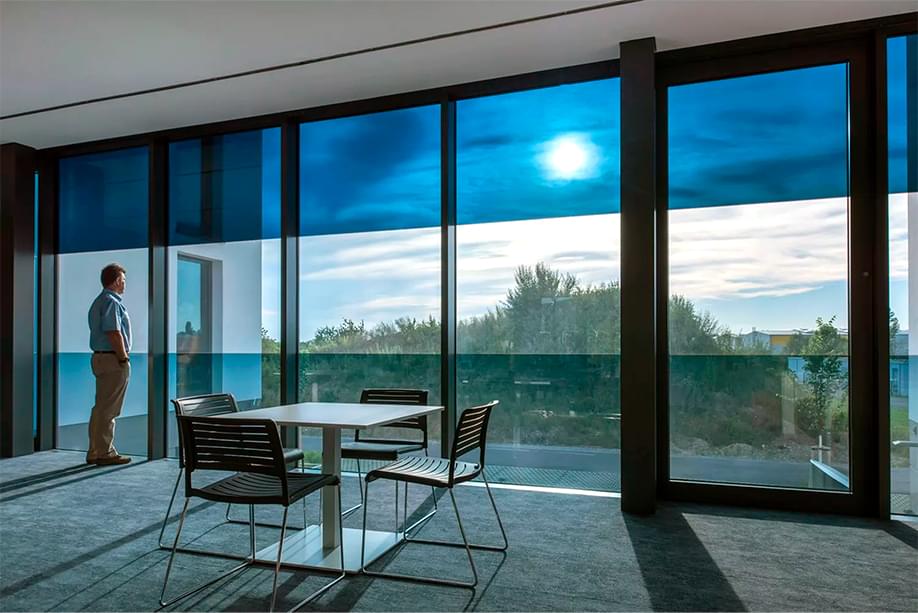Insulating glass (IG) consists of two or more glass window panes separated by a space to reduce heat transfer across a part of the building envelope. A window with insulating glass is commonly known as double glazing or a double-paned window, triple glazing or a triple-paned window, or quadruple glazing or a quadruple-paned window, depending upon how many panes of glass are used in its construction.
Insulating glass units (IGUs) are typically manufactured with glass in thicknesses from 3 to 10 mm (1/8″ to 3/8″). Thicker glass is used in special applications. Laminated or tempered glass may also be used as part of the construction. Most units are produced with the same thickness of glass on both panes but special applications such as acoustic attenuation or security may require different thicknesses of glass to be incorporated in a unit.
The space in between the panes provides the bulk of the insulation effect. It can be filled with air, but in thee past argon was sometimes used. However, currently a channel internal between the 2 panes of glass is filled with desiccant and a dead airspace created providing the required insulating properties.
History
A typical installation of insulated glass windows with PVC frames Fitting a second pane of glass to improve insulation began in Scotland, Germany, and Switzerland in the 1870s. Insulating glass is an evolution from older technologies known as double-hung windows and storm windows. Traditional double-hung windows used a single pane of glass to separate the interior and exterior spaces. In the summer, a window screen would be installed on the exterior over the double-hung window to keep out animals and insects.
In the winter, the screen was removed and replaced with a storm window, which created a two-layer separation between the interior and exterior spaces, increasing window insulation in cold winter months. To permit ventilation, the storm window may be hung from removable hinge loops and swung open using folding metal arms. No screening was usually possible with open storm windows, though in the winter, insects typically are not active.
Traditional storm windows and screens are relatively time-consuming and labor-intensive, requiring removal and storage of the storm windows in the spring and reinstallation in the fall and storage of the screens.
The weight of the large storm window frame and glass makes replacement on upper-stories of tall buildings a difficult task requiring repeatedly climbing a ladder with each window and trying to hold the window in place while securing retaining clips around the edges. However, current reproductions of these old-style storm windows can be made with detachable glass in the bottom pane that can be replaced with a detachable screen when desired. This eliminates the need for changing the entire storm window according to the seasons.

Insulated glazing (IG) forms a very compact multi-layer sandwich of air and glass, which eliminates the need for storm windows. Screens may also be left installed year-round with insulated glazing, and they can be installed in a manner that permits installation and removal from inside the building, eliminating the requirement to climb up the exterior of the house to service the windows. It is possible to retrofit insulated glazing into traditional double-hung frames, though this would require significant modification to the wood frame due to the increased thickness of the IG assembly.
Modern window units with IG typically completely replace the older double-hung unit and include other improvements such as better sealing between the upper and lower windows and spring-operated weight balancing that removes the need for large hanging weights inside the wall next to the windows, allowing for more insulation around the window and reducing air leakage. IG provides robust protection against the sun and keeps the house cool in the hot summer and warm in winter. The spring-operated balancing mechanisms also typically permit the top of the windows to swing inward, permitting cleaning of the exterior of the IG window from inside the building.
The insulating glazing unit, consisting of two glass panes bound together into a single unit with a seal between the edges of the panes, was patented in the United States by Thomas Stetson in 1865.[3]
It was developed into a commercial product in the 1930s, when several patents were filed, and a product was announced by the Libbey-Owens-Ford Glass Company in 1944. Their product was sold under the Thermopane brand name, which had been registered as a trademark in 1941. The Thermopane technology differs significantly from contemporary IGUs. The two panes of glass were welded together by a glass seal, and the two panes were separated by less than the 0.5 inches (1.3 cm) typical of modern units.[5] The brand name Thermopane has entered the vocabulary of the glazing industry as the genericized trademark for any IGU.


